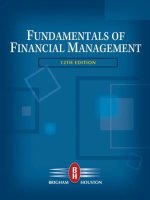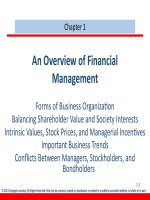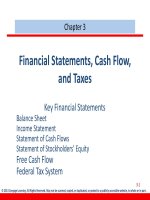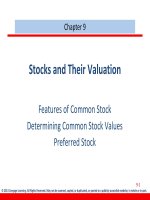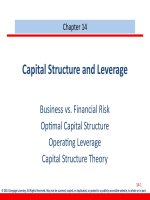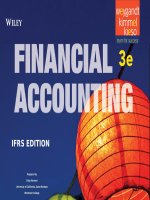Fundamental of financial management 13th ed brigham houston chapter 09
Bạn đang xem bản rút gọn của tài liệu. Xem và tải ngay bản đầy đủ của tài liệu tại đây (120.58 KB, 31 trang )
Chapter 9
Stocks and Their Valuation
Features of Common Stock
Determining Common Stock Values
Preferred Stock
9-1
© 2013 Cengage Learning. All Rights Reserved. May not be scanned, copied, or duplicated, or posted to a publicly accessible website, in whole or in part.
Facts about Common Stock
•
•
•
•
•
Represents ownership
Ownership implies control
Stockholders elect directors
Directors elect management
Management’s goal: Maximize the stock price
9-2
© 2013 Cengage Learning. All Rights Reserved. May not be scanned, copied, or duplicated, or posted to a publicly accessible website, in whole or in part.
Intrinsic Value and Stock Price
•
Outside investors, corporate insiders, and analysts
use a variety of approaches to estimate a stock’s
intrinsic value (P0).
•
In equilibrium we assume that a stock’s price
equals its intrinsic value.
– Outsiders estimate intrinsic value to help determine
which stocks are attractive to buy and/or sell.
– Stocks with a price below (above) its intrinsic value
are undervalued (overvalued).
9-3
© 2013 Cengage Learning. All Rights Reserved. May not be scanned, copied, or duplicated, or posted to a publicly accessible website, in whole or in part.
Determinants of Intrinsic Value and Stock Prices
Managerial Actions, the Economic Environment,
Taxes, and the Political Climate
“True”
Risk
“Perceived” Investor
Cash Flows
Stock’s
Intrinsic Value
“Perceived”
Risk
Stock’s
Market Price
Market Equilibrium:
Intrinsic Value = Stock Price
9-4
© 2013 Cengage Learning. All Rights Reserved. May not be scanned, copied, or duplicated, or posted to a publicly accessible website, in whole or in part.
Different Approaches for Estimating the Intrinsic
Value of a Common Stock
•
•
•
•
Discounted dividend model
Corporate valuation model
P/E multiple approach
EVA approach
9-5
© 2013 Cengage Learning. All Rights Reserved. May not be scanned, copied, or duplicated, or posted to a publicly accessible website, in whole or in part.
Discounted Dividend Model
•
Value of a stock is the present value of the future
dividends expected to be generated by the stock.
Pˆ0 =
D3
D1
D2
D∞
+
+
+ ... +
1
2
3
(1 + rs ) (1 + rs ) (1 + rs )
(1 + rs )∞
9-6
© 2013 Cengage Learning. All Rights Reserved. May not be scanned, copied, or duplicated, or posted to a publicly accessible website, in whole or in part.
Constant Growth Stock
•
A stock whose dividends are expected to grow
forever at a constant rate, g.
D1 = D0(1 + g)1
D2 = D0(1 + g)2
Dt = D0(1 + g)t
•
If g is constant, the discounted dividend formula
converges to:
ˆP0 = D0 (1 + g) = D1
rs − g
rs − g
9-7
© 2013 Cengage Learning. All Rights Reserved. May not be scanned, copied, or duplicated, or posted to a publicly accessible website, in whole or in part.
Future Dividends and Their Present Values
$
0.25
D t = D0 (1 + g)t
Dt
PVD t =
( 1 + r )t
P0 = ∑ PVD t
0
Years (t)
9-8
© 2013 Cengage Learning. All Rights Reserved. May not be scanned, copied, or duplicated, or posted to a publicly accessible website, in whole or in part.
What happens if g > rs?
•
If g > rs, the constant growth formula leads to a
negative stock price, which does not make sense.
•
The constant growth model can only be used if:
– r > g.
– g is expected to be constant forever.
s
9-9
© 2013 Cengage Learning. All Rights Reserved. May not be scanned, copied, or duplicated, or posted to a publicly accessible website, in whole or in part.
Use the SML to Calculate the Required
Rate of Return (rs)
•
If rRF = 7%, rM = 12%, and b = 1.2, what is the required
rate of return on the firm’s stock?
rs
= rRF + (rM – rRF)b
= 7% + (12% – 7%)1.2
= 13%
9-10
© 2013 Cengage Learning. All Rights Reserved. May not be scanned, copied, or duplicated, or posted to a publicly accessible website, in whole or in part.
Find the Expected Dividend Stream for the Next
3 Years and Their PVs
D0 = $2 and g is a constant 6%.
0
g = 6%
1.8761
1.7599
1
2
2.12
2.247
3
2.382
rs = 13%
1.6509
9-11
© 2013 Cengage Learning. All Rights Reserved. May not be scanned, copied, or duplicated, or posted to a publicly accessible website, in whole or in part.
What is the stock’s intrinsic value?
Using the constant growth model:
ˆP0 = D1 = $2.12
rs − g 0.13 − 0.06
$2.12
=
0.07
= $30.29
9-12
© 2013 Cengage Learning. All Rights Reserved. May not be scanned, copied, or duplicated, or posted to a publicly accessible website, in whole or in part.
What is the stock’s expected value, one year
from now?
•
D1 will have been paid out already. So, expected P1
is the present value (as of Year 1) of D2, D3, D4, etc.
ˆ1 = D 2 = $2.247
P
rs − g 0.13 − 0.06
= $32.10
•
ˆ1 = P0 (1.06) = $32.10
P
Could also find expected
P1 as:
9-13
© 2013 Cengage Learning. All Rights Reserved. May not be scanned, copied, or duplicated, or posted to a publicly accessible website, in whole or in part.
Find Expected Dividend Yield, Capital Gains Yield, and
Total Return During First Year
•
Dividend yield
= D1/P0 = $2.12/$30.29 = 7.0%
•
Capital gains yield
= (P1 – P0)/P0
= ($32.10 – $30.29)/$30.29 = 6.0%
•
Total return (rs)
= Dividend yield + Capital gains yield
= 7.0% + 6.0% = 13.0%
9-14
© 2013 Cengage Learning. All Rights Reserved. May not be scanned, copied, or duplicated, or posted to a publicly accessible website, in whole or in part.
What would the expected price today be,
if g = 0?
The dividend stream would be a perpetuity.
0
rs = 13%
1
2
3
2.00
2.00
2.00
ˆP0 = PMT = $2.00 = $15.38
r
0.13
9-15
© 2013 Cengage Learning. All Rights Reserved. May not be scanned, copied, or duplicated, or posted to a publicly accessible website, in whole or in part.
Supernormal Growth: What if g = 30% for 3 years
before achieving long-run growth of 6%?
•
Can no longer use just the constant growth model
to find stock value.
•
However, the growth does become constant after 3
years.
9-16
© 2013 Cengage Learning. All Rights Reserved. May not be scanned, copied, or duplicated, or posted to a publicly accessible website, in whole or in part.
Valuing Common Stock with Nonconstant Growth
D0 = $2.00.
0 rs = 13%
g = 30%
2.301
2.647
3.045
46.114
ˆ0
54.107 = P
1
2
g = 30%
2.600
3
g = 30%
3.380
Pˆ3 =
4
g = 6%
4.394
4.658
4.658
= $66.54
0.13 − 0.06
9-17
© 2013 Cengage Learning. All Rights Reserved. May not be scanned, copied, or duplicated, or posted to a publicly accessible website, in whole or in part.
Find Expected Dividend and Capital Gains Yields
During the First and Fourth Years
•
Dividend yield (first year)
= $2.60/$54.11 = 4.81%
•
Capital gains yield (first year)
= 13.00% – 4.81% = 8.19%
•
During nonconstant growth, dividend yield and
capital gains yield are not constant, and capital
gains yield ≠ g.
•
After t = 3, the stock has constant growth and
dividend yield = 7%, while capital gains yield = 6%.
9-18
© 2013 Cengage Learning. All Rights Reserved. May not be scanned, copied, or duplicated, or posted to a publicly accessible website, in whole or in part.
Nonconstant Growth: What if g = 0% for 3 years
before long-run growth of 6%?
D0 = $2.00.
0 r = 13%
s
g = 0%
1
2
g = 0%
2.00
3
g = 0%
2.00
4
g = 6%
2.00
2.12
1.77
1.57
1.39
20.99
ˆ0
25.72 = P
Pˆ3 =
2.12
= $30.29
0.13 − 0.06
9-19
© 2013 Cengage Learning. All Rights Reserved. May not be scanned, copied, or duplicated, or posted to a publicly accessible website, in whole or in part.
Find Expected Dividend and Capital Gains Yields
During the First and Fourth Years
•
Dividend yield (first year)
= $2.00/$25.72 = 7.78%
•
Capital gains yield (first year)
= 13.00% – 7.78% = 5.22%
•
After t = 3, the stock has constant growth and
dividend yield = 7%, while capital gains yield = 6%.
9-20
© 2013 Cengage Learning. All Rights Reserved. May not be scanned, copied, or duplicated, or posted to a publicly accessible website, in whole or in part.
If the stock was expected to have negative growth (g =
-6%), would anyone buy the stock, and what is its value?
•
Yes. Even though the dividends are declining, the stock
is still producing cash flows and therefore has positive
value.
D (1 + g)
D
Pˆ0 = 1 = 0
rs − g
rs − g
$2.00 (0.94) $1.88
=
=
= $9.89
0.13 − (-0.06) 0.19
9-21
© 2013 Cengage Learning. All Rights Reserved. May not be scanned, copied, or duplicated, or posted to a publicly accessible website, in whole or in part.
Find Expected Annual Dividend and Capital
Gains Yields
•
Capital gains yield
= g = -6.00%
•
Dividend yield
= 13.00% – (-6.00%) = 19.00%
•
Since the stock is experiencing constant growth,
dividend yield and capital gains yield are constant.
Dividend yield is sufficiently large (19%) to offset
negative capital gains.
9-22
© 2013 Cengage Learning. All Rights Reserved. May not be scanned, copied, or duplicated, or posted to a publicly accessible website, in whole or in part.
Corporate Valuation Model
•
Also called the free cash flow method. Suggests the
value of the entire firm equals the present value of
the firm’s free cash flows.
•
Remember, free cash flow is the firm’s after-tax
operating income less the net capital investment.
Depr. and Capital
FCF = EBIT(1 − T) +
−
+ ∆ NOWC
amortization expenditur es
9-23
© 2013 Cengage Learning. All Rights Reserved. May not be scanned, copied, or duplicated, or posted to a publicly accessible website, in whole or in part.
Applying the Corporate Valuation Model
•
Find the market value (MV) of the firm, by finding
the PV of the firm’s future FCFs.
•
Subtract MV of firm’s debt and preferred stock to
get MV of common stock.
•
Divide MV of common stock by the number of
shares outstanding to get intrinsic stock price
(value).
9-24
© 2013 Cengage Learning. All Rights Reserved. May not be scanned, copied, or duplicated, or posted to a publicly accessible website, in whole or in part.
Issues Regarding the Corporate Valuation Model
•
Often preferred to the discounted dividend model,
especially when considering number of firms that
don’t pay dividends or when dividends are hard to
forecast.
•
Similar to discounted dividend model, assumes at
some point free cash flow will grow at a constant
rate.
•
Horizon value (HVN) represents value of firm at the
point that growth becomes constant.
9-25
© 2013 Cengage Learning. All Rights Reserved. May not be scanned, copied, or duplicated, or posted to a publicly accessible website, in whole or in part.

